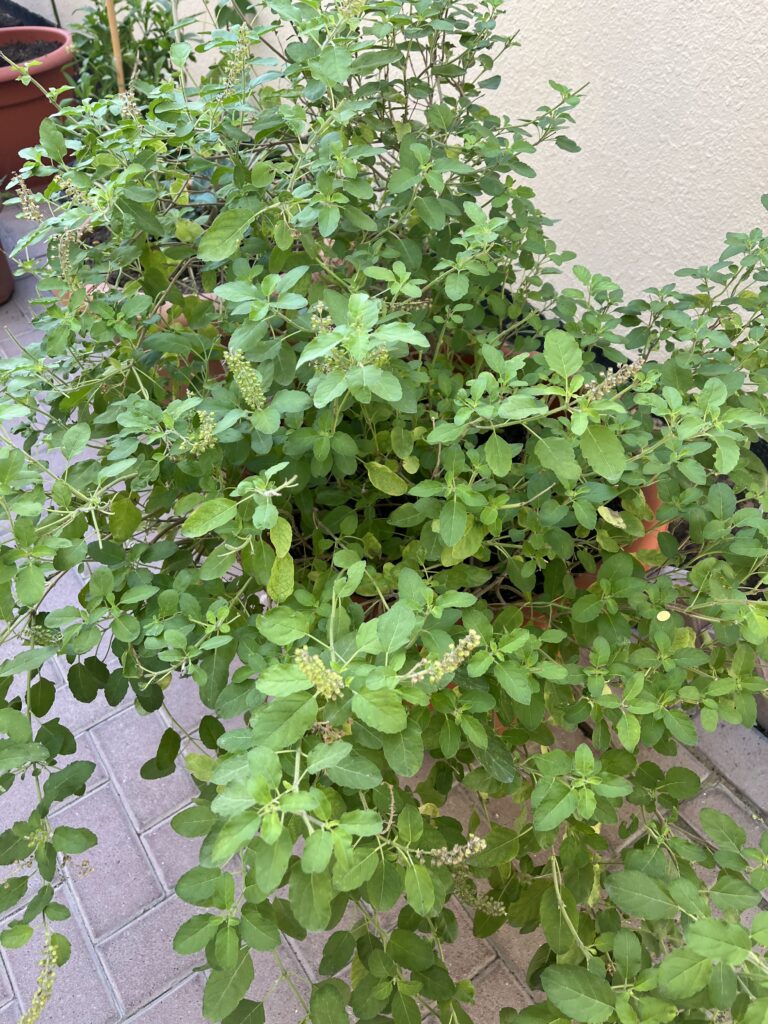The legend of the Tulsi plant resonates all over India. Used for religious as well medicinal purposes it has a delicious flavor and goes well with any sweets. In fact, no offering to Lord Vishnu is made without Tulsi leaves. But I digress. The Holy Basil aka Tulsi is really full of health benefits mainly as an anti-allergen and as a cold and cough remedy. It is surprisingly effective when taken every two hours when you start a cold. The only thing you must avoid is chewing on the leaves as it does contain mercury which causes discoloration of the tooth enamel. Just swallow it whole or tear it into tiny bits and swallow it with a mouthful of water.
Tulsi or Holy Basil as I said is sacred to the Hindus. It needs a lot of sunlight and regular watering but a well-draining rich soil. It has many medicinal properties but is best known for its astringent and anti-allergic and anti-inflammatory properties. I am attaching a link here for the many uses of Tulsi leaves and many thanks to the author.
https://facty.com/lifestyle/wellness/10-health-benefits-of-tulsi/10/?da=true&daInit=1
Although stories and legends specify why the Tulsi is kept outdoors it is mainly because it requires a lot of direct sunlight. Trim off the flowers regularly using a sharp and sanitized tool. Some people claim that you need to pinch off the flowers only but perhaps that is more to avoid spreading infection from an infected tool. A lot of religious dos and don’ts are rooted in practical wisdom and logic.
Tulsi is meant to be kept on the eastern side of your house or northeast as that receives the most beneficial sunlight. It does not do too well if exposed to strong winds either. It is also prone to spider mites as with all Basil varieties. Prune regularly removing the seeds and dropping them into the same pot and do not allow the plant to get woody and leggy. While a rich home compost is good for the plant, people use a variety of ferments to gently fertilize the plant. Use fermented rice wash water regularly to fertilize. Also, leftover dosa batter diluted 10-20 times in water is great for Tulsi and other Basil varieties. Using fermented and diluted buttermilk is also great for the plant.
Propagation is by seeds or you can propagate by rooting in water. Remove all but a few leaves on top of the woody cutting and immerse n water exposing the container to lots of sunlight. Change the water every 2-3 days and you will find roots developing. You can also use cinnamon powder and honey or a rooting hormone and stick the cutting in soil and it can be rooted. Do this in early March here in the Gulf or late October and your chances of success are very high.
Actually, there are mainly 3 types of Tulsi cultivated in India and used for their healing properties. Rama or green leaf Tulsi, Shyam or purple leaf Tulsi, and Vana or wild Tulsi. The Shyam Tulsi has a more peppery flavor and is very effective for coughs and colds while the Rama Tulsi is gentler in taste.
Use Tulsi leaves boiled in water with a little honey when your children have a cold and it will soothe their throat and relieve the pain of the sinus inflammation. Please note this is not a replacement for a doctor’s visit but as a gentle supplement to relieve the symptoms and make the child more comfortable,







Recent Comments